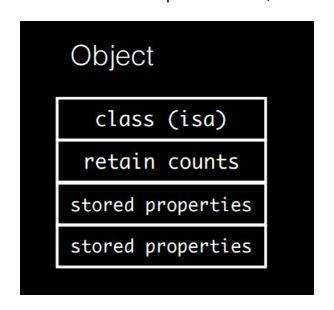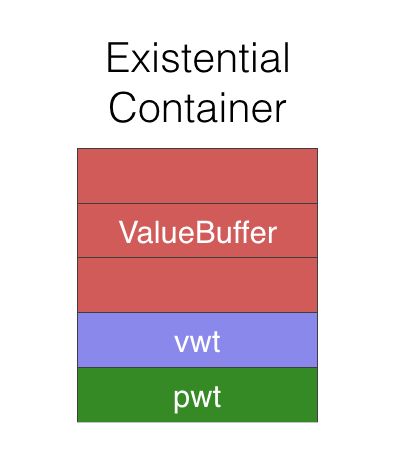前言
阿里云APP组件化过程中,我们拆分出了若干基础组件库和业务代码库,由于代码是采用Swift编写的,所以这些库都是动态库形式。在上一个正式版本,组件化达到了完全形态,主工程只剩下一个壳,所有代码都以pod组件的形式引入,最后交付的是一个主工程的壳二进制程序,和十几个动态库Framework。这些动态库都是运行时才链接到主程序中的。
开发中,我们在某个组件上工作时,其他组件也都是以动态库二进制形式引入的,节省Rebuild源码成本。但开发过程中我们遇到了一些问题。
遇到问题
组件拆分出来以后,无可避免,组件之间会存在一些非扁平的依赖关系,如A依赖B依赖C,同时A依赖C。开发A过程中,可能有需要改动C的情况,于是我们将C更新、打包、发布,而B保持不变(只有A用到C加的特性),A依赖C的新版本继续开发。但我们发现,有一些改动会导致APP闪退,只有在B重新依赖C的新版本也编译、打包、发布新版本之后,才恢复正常。我们注意到,出现这种情况时,一般是我们改动了A中某些类的属性。显而易见,我们遇到的是二进制兼容性问题。
理论上ObjC使用静态库也会遇到这种问题的,但是ObjC2.0引入了non-fragile特性,同时runtime中采用消息转发实现方法调用,规避了大部分会引起ABI不兼容的情况。所以在ObjC中,只要接口兼容,底层组件改动一般是不需要自下往上重新编译链接的。
而Swift,在我们认识里,它没有ObjC那么“动态”,又不像C/C++那么直接(寻址是基地址+偏移量,内存布局改变引起ABI不兼容),那它会存在哪些能引起ABI不兼容的情况呢?上个版本我们没有弄明白,保险起见,底层改动后我们都把上层重新编译连接,非常蛋疼。所以,这两天我尝试把这个问题弄清楚。
复现实例
我们准备三个代码文件:
// Foo.swift
public class SimpleClass {
public var x: Int = 0
public var y: Int = 0
public init() {
x = 1
y = 2
}
public func sum() -> Int {
return x + y
}
}
// Bar.swift
import Foo
public func bar() -> Int {
return SimpleClass().sum()
}
// main.swift
import Foundation
import Foo
import Bar
print("bar \(bar())")
然后分别编译出动态库,链接到main,运行:
$ swiftc -emit-module -emit-library Foo.swift
$ swiftc -emit-module -emit-library Bar.swift -I. -L. -lFoo
$ swiftc -I. -L. -lFoo -lBar main.swift
$ ./main
bar 3 // output
然后我们给Foo.swift增加一个字段diff:
// Foo.swift
public class SimpleClass {
public var diff: Int?
public var x: Int = 0
public var y: Int = 0
public init() {
x = 1
y = 2
}
public func sum() -> Int {
return x + y
}
}
单独编译Foo.swift,Bar.swift和main.swift不再重新编译:
$ swiftc -emit-module -emit-library Foo.swift
$ ./main
[1] 52482 segmentation fault ./main // output
$ swiftc -I. -L. -lFoo -lBar main.swift
[1] 52645 segmentation fault ./main // output
可以看到,无论是否重新编译main,只要不重新编译Bar,运行main就会闪退。
排查
我们没有挑选一些在C/C++里容易理解的ABI不兼容的场景,如直接引用发生变化的对象成员变量,继承关系下父类字段增删等。上述复现实例中,我们在SimpleClass这个类中增加了字段,改变了对象的内存布局,但是,按照C/C++的思路,我们并未在Bar中直接引用任何成员变量,为什么会出现错误呢?我们也已经知道,Swift方法调用依赖vtable,但我们也并未对实例方法做增删。
还是要从内存布局说起。
对象内存布局
Swift对象的内存布局我也是这两天慢慢明白过来的,现在放在最前头,后边说起来就容易理解了。在上一次我为了实现HandyJSON做这方面调研的时候,这一块资料很少,但现在情况不同了。特别推荐Mike Ash的一个分享视频,他的思路很棒,主要依赖mach_vm_read_overwrite和dladder两个系统函数。前者利用系统调用检查一个指针是否合法,后者检查一个内存地址上是否绑定了什么symbol。基于此,从一个对象的起始指针出发,广度遍历一下可见的内存,构造指针继续往下,最后将得到和这个对象相关的所有地址、所有符号,把这些信息生成一张图,最后大概是这个样子(这个是简单情况):
从这个视频,我们知道,普通Swift对象,即使是纯Swift对象,其实instance的布局也是和ObjC保持一致,大概是这样:
我们打开Swift ABI文档。在Class Metadata这一章节,我们看到,在ObjC中,isa指向一个Class类对象,Swift类似,但指向的是一个与Class类兼容的metadata,这个metadata用Class *去解释是没有问题的,同时它尾部追加了Swift中使用的一些字段。比如vtable。vtable相关的资料,可以参考:Swift Method Dispatching。
我们直接将Foo.swift编译为汇编代码(swiftc -S Foo.swift):
525 __TWoFC3Foo11SimpleClass3sumfT_Si:
526 .quad 152
527
528 .globl __TMLC3Foo11SimpleClass
529 .zerofill __DATA,__common,__TMLC3Foo11SimpleClass,8,3
530 .section __DATA,__data
531 .align 3
532 __TMfC3Foo11SimpleClass:
533 .quad __TFC3Foo11SimpleClassD
534 .quad __TWVBo
535 .quad __TMmC3Foo11SimpleClass // isa指向的位置
536 .quad _OBJC_CLASS_$_SwiftObject
537 .quad __objc_empty_cache
538 .quad 0
539 .quad l__DATA__TtC3Foo11SimpleClass+1
540 .long 3
541 .long 0
542 .long 32
543 .short 7
544 .short 0
545 .long 176
546 .long 16
547 .quad __TMnC3Foo11SimpleClass-(__TMfC3Foo11SimpleClass+80)
548 .quad 0
549 .quad __TFC3Foo11SimpleClassg1xSi // vTable起点
550 .quad __TFC3Foo11SimpleClasss1xSi
551 .quad __TFC3Foo11SimpleClassm1xSi
552 .quad __TFC3Foo11SimpleClassg1ySi
553 .quad __TFC3Foo11SimpleClasss1ySi
554 .quad __TFC3Foo11SimpleClassm1ySi
555 .quad __TFC3Foo11SimpleClasscfT_S0_
556 .quad __TFC3Foo11SimpleClass3sumfT_Si // sum方法
557 .quad 16
558 .quad 24
559
560 .section __TEXT,__swift3_typeref,regular,no_dead_strip
561 .align 4
562 L___unnamed_7:
563 .asciz "C3Foo11SimpleClass"
然后demangle相关的几个符号:
$ xcrun swift-demangle *
output:
_TMmC3Foo11SimpleClass ---> metaclass for Foo.SimpleClass
_TMfC3Foo11SimpleClass ---> full type metadata for Foo.SimpleClass
_TFC3Foo11SimpleClassD ---> Foo.SimpleClass.__deallocating_deinit
_TMmC3Foo11SimpleClass ---> metaclass for Foo.SimpleClass
_TMnC3Foo11SimpleClass ---> nominal type descriptor for Foo.SimpleClass
_TMfC3Foo11SimpleClass ---> full type metadata for Foo.SimpleClass
_TFC3Foo11SimpleClassg1xSi ---> Foo.SimpleClass.x.getter : Swift.Int
_TFC3Foo11SimpleClasss1xSi ---> Foo.SimpleClass.x.setter : Swift.Int
_TFC3Foo11SimpleClassm1xSi ---> Foo.SimpleClass.x.materializeForSet : Swift.Int
_TFC3Foo11SimpleClass3sumfT_Si ---> Foo.SimpleClass.sum () -> Swift.Int
很棒,一切符合预期。
调用细节
然后我们看一下Bar.swift中发生了什么(swiftc -I. -L. -lFoo -S Bar.swift):
38 __TF3Bar3barFT_Si:
39 .cfi_startproc
40 pushq %rbp
41 Ltmp3:
42 .cfi_def_cfa_offset 16
43 Ltmp4:
44 .cfi_offset %rbp, -16
45 movq %rsp, %rbp
46 Ltmp5:
47 .cfi_def_cfa_register %rbp
48 subq $32, %rsp
49 callq __TMaC3Foo11SimpleClass
50 movq %rax, %rdi
51 callq __TFC3Foo11SimpleClassCfT_S0_ // 构造SimpleClass实例
52 movq (%rax), %rdi
53 movq %rdi, -8(%rbp)
54 movq %rax, %rdi
55 movq -8(%rbp), %rcx
56 movq %rax, -16(%rbp)
57 callq *136(%rcx) // 调用sum方法
58 movq -16(%rbp), %rdi
59 movq %rax, -24(%rbp)
60 callq _rt_swift_release
61 movq -24(%rbp), %rax
62 addq $32, %rsp
63 popq %rbp
64 retq
65 .cfi_endproc
跳过细节,我们直接看line 57: callq *136(%rcx)行,这正是对sum方法的调用。rcx寄存器存储的值为SimpleClass.metadata的起始指针,偏移136字节后,便是上述中_TFC3Foo11SimpleClass3sumfT_Si ---> Foo.SimpleClass.sum () -> Swift.Int符号。
引起不兼容的原因
这时候我们就可以考虑一下,在复现实例中,我们加入diff字段发生的事情了。加入diff字段后重新编译Foo.swift,可以看到汇编代码中metadata布局变成了:
671 .quad __TMnC3Foo11SimpleClass-(__TMfC3Foo11SimpleClass+80)
672 .quad 0
673 .quad __TFC3Foo11SimpleClassg4diffGSqSi_
674 .quad __TFC3Foo11SimpleClasss4diffGSqSi_
675 .quad __TFC3Foo11SimpleClassm4diffGSqSi_
676 .quad __TFC3Foo11SimpleClassg1xSi
677 .quad __TFC3Foo11SimpleClasss1xSi
678 .quad __TFC3Foo11SimpleClassm1xSi
679 .quad __TFC3Foo11SimpleClassg1ySi
680 .quad __TFC3Foo11SimpleClasss1ySi
681 .quad __TFC3Foo11SimpleClassm1ySi
682 .quad __TFC3Foo11SimpleClasscfT_S0_
683 .quad __TFC3Foo11SimpleClass3sumfT_Si
也就是说,Swift为新增的字段添加了三个方法,插在vtable其他方法的前面。这时候,__TFC3Foo11SimpleClass3sumfT_Si的位置就变了,而Bar中仍然以callq *136(%rcx)调用sum函数,自然就发生了错误,导致闪退。
其他情况
上述例子主要是展示了一种研究ABI兼容性的思路。据此,我们可以研究其他情况。
Struct
Swift中,Struct不允许继承,所以它的方法派发不必要依赖vtable实现,而是直接被编译为全局函数(未研究可见修饰符的影响)。那它还会遇到Class中遇到的问题吗?测试结果是,仍然会。我们把SimpleClass修改为SimpleStruct,同时直接在x和y字段之间增加diff字段方便印证逻辑,看下Bar中的变化:
// Foo.swift节选
public struct SimpleStruct {
public var x: Int = 0
public var diff: Int = 0
public var y: Int = 0
...
}
// foo.s节选
63 __TFV3Foo12SimpleStruct3sumfT_Si:
64 .cfi_startproc
65 pushq %rbp
66 Ltmp6:
67 .cfi_def_cfa_offset 16
68 Ltmp7:
69 .cfi_offset %rbp, -16
70 movq %rsp, %rbp
71 Ltmp8:
72 .cfi_def_cfa_register %rbp
73 addq %rdx, %rdi // .x + .y
74 seto %al
75 movq %rsi, -8(%rbp)
76 movq %rdi, -16(%rbp)
77 movb %al, -17(%rbp)
78 jo LBB2_2
79 movq -16(%rbp), %rax
80 popq %rbp
81 retq
82 LBB2_2:
83 ud2
84 .cfi_endproc
// bar.s节选
46 Ltmp5:
47 .cfi_def_cfa_register %rbp
48 callq __TFV3Foo12SimpleStructCfT_S0_
49 movq %rax, %rdi // .x
50 movq %rdx, %rsi
51 movq %rcx, %rdx // .y
52 callq __TFV3Foo12SimpleStruct3sumfT_Si
53 popq %rbp
54 retq
55 .cfi_endproc
可以看到,在bar.s中,调用sum时直接调用全局符号来完成的,而非Class中以偏移量实现。而且,在调用前,参数并不是以指向struct实例的指针方式提供self.,而是直接传值!传值过程依赖于SimpleStruct的内存布局,所以,一旦布局改变,这里就会发生错误。
Protocol
参考Swift进阶之内存模型和方法调度一文,Swift对于协议类型的采用如下的内存模型 - Existential Container:
Existential Container包括以下三个部分:
- 前三个word:Value buffer。用来存储Inline的值,如果word数大于3,则采用指针的方式,在堆上分配对应需要大小的内存
- 第四个word:Value Witness Table(VWT)。每个类型都对应这样一个表,用来存储值的创建,释放,拷贝等操作函数。
- 第五个word:Protocol Witness Table(PWT),用来存储协议的函数。
那么,显然,如果属性增删导致属性存储区在栈、堆之间变化,或者类的方法(包括可见属性的getter、setter)增删引起vtable变化,都会引起不兼容问题。
Extension
我们常常在各个地方为类增加扩展,显然它是不会引起不兼容问题的。为Foo.swift增加一个扩展,其中实现一个空方法f0(),我们从汇编代码可以看到只是增加了一个global方法定义:
320 .globl __TFC3Foo11SimpleClass2f0fT_T_
321 .align 4, 0x90
322 __TFC3Foo11SimpleClass2f0fT_T_:
323 .cfi_startproc
324 pushq %rbp
325 Ltmp39:
326 .cfi_def_cfa_offset 16
327 Ltmp40:
328 .cfi_offset %rbp, -16
329 movq %rsp, %rbp
330 Ltmp41:
331 .cfi_def_cfa_register %rbp
332 movq %rdi, -8(%rbp)
333 popq %rbp
334 retq
335 .cfi_endproc
静态方法
静态方法和扩展类似,只是增加了global方法定义,不会影响到类的metadata,所以不会引起不兼容问题。
总结
Swift 3出来时,我们曾看到Chris Lattner的邮件: 回顾Swift3,展望Swift4。他提到Swift4阶段1的任务时说:
- Resilience: This provides a way for public APIs to evolve over time, even in the face of ABI stability. For example, we don’t want the C++ “fragile base class" problem to ever exist in Swift. ** Much of the design and implementation work was done in the Swift 3 timeframe**, but there are still major missing pieces, including the user-visible part of the model (e.g. new attributes).
现在看起来,Swift的整个设计完全是静态的,"易碎的"(fragile),这使得Much of the design and implementation work was done in the Swift 3 timeframe这句话让我十分费解。我不知道是不是我理解的方向都错了。
但回到我们工程,这个问题已经拦在前面了,我们只能尽量不要频繁在底层组件做非二进制兼容的改动,即使有必要,我们也应该找到一个方案,自动化地完成有时序依赖的构建过程。
更多的情况,我将继续研究,大家有不同的见解,欢迎交流~
Reference
- http://quotation.github.io/objc/2015/05/21/objc-runtime-ivar-access.html
- http://llvm.org/docs/LangRef.html#getelementptr-instruction
- https://github.com/apple/swift/blob/master/docs/ABI.rst#class-metadata
- http://www.jianshu.com/p/6495a6ce65ed
- http://allegro.tech/2014/12/swift-method-dispatching.html
- https://www.cs.cmu.edu/~fp/courses/15213-s07/misc/asm64-handout.pdf
- https://www.lri.fr/~filliatr/ens/compil/x86-64.pdf
- http://www.imada.sdu.dk/Courses/DM18/Litteratur/IntelnATT.htm
- https://www.youtube.com/watch?v=ERYNyrfXjlg&feature=youtu.be
- https://developer.apple.com/videos/play/wwdc2014/404/
- https://developer.apple.com/videos/play/wwdc2016/416/
- https://developer.apple.com/videos/play/wwdc2015/409/
- http://www.atatech.org/articles/69335



